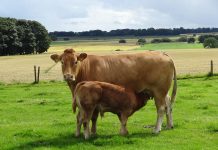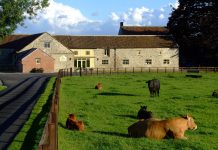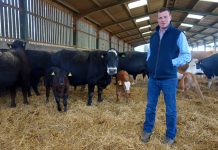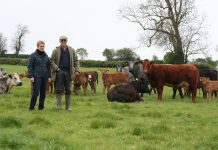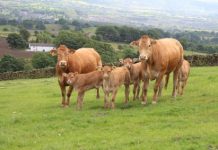“There’s nowt to beat a Limmy,” is a phrase that John Richardson often uses when asked to describe his favourite breed of cattle. As a producer of high quality suckled calves, he thinks the Limousin has characteristics that set it apart from the competition.
It has certainly served him well in the show ring, where homebred livestock from the 1000 acre Ghyll House Farm have been in the ribbons on countless occasions.
John and his wife, Dorne, are based in the picturesque village of Dufton, near Appleby in Cumbria. The holding also has grazing rights on the nearby 13,000 acre common. The commercial herd of 200 females is made up of mainly three-quarter Limousins, put to one of the farm’s Limousin bulls. However, Belgian Blue and Charolais sires also run with selected cows, to give a broader range of genetic options. Calving is all year round, with the herd split into five groups. “All year round calving helps with cash flow because I always have something to sell,” says John. “It also gives me a varied age group when I am picking my show team.” Calves aged between five and 12 months old are sold through Penrith Auction Mart’s store cattle ring. Around 25 head with show potential are offered for sale at Penrith’s Spring Show in March each year. “The market for show cattle seems to be rising,” says John. “Some of my heifers go to other farms for breeding, but an increasing number attract bids from people who show cattle as a hobby.”
John puts a lot of effort into choosing bulls that he thinks will complement his stamp of female. Selection is mostly based on visual appearance, although pedigree bloodlines and EBVs are also taken into account. When looking for a bull, he prefers the shorter-type cattle. He also likes to see “a sweet head, good legs and loins and tightness around the belly.” One of his most successful acquisitions has been the French import, Rossignol, an eight- year-old bull by Jacot. Rossignol sired 20 of the calves that achieved a £3,500 average price at Penrith last year. A purchase much closer to home was the 2001-born Liscon Sepp, a Middledale Ontheball son bought privately from Jimmy Mulholland of Orton, Cumbria. Sepp is used mainly on heifers and distinguished himself after two of his progeny were chosen as Champion and Reserve at the previous year’s Spring Show and Sale of Limousins at Penrith. The animals subsequently sold for £5,500 and £3,500 respectively.
A high percentage of females in the herd are by the now-deceased Muirhouse Lagonda, by Mereside Challenger. From George Anderson of Wishaw, Lanarkshire, the bull cost 9,000gns, and was worth every penny, according to John. Another noted import is Volcano, a four year old by Sablier. On his arrival at Ghyll House in 2006, he was run with four bulling heifers. One of the calves, subsequently snapped up by Gavin Scott of Linlithgow, was awarded the Butcher’s Supreme Championship at the 2007 Scottish Winter Fair. Volcano has such tremendous conformation that he has sired 10 out of the 30-strong Ghyll House team currently being trained for the 2008 show circuit, says John, who is also a noted breeder of Swaledale sheep.
However, he only shows cattle that he is selling, a policy that he has pursued since 1995. “Showing is a combination of business and pleasure,” he comments. “As well as giving me an interest, show winners also bring my average price up, which is good for business. I agree with the saying that it’s just as expensive to keep a good animal as it is to keep a poor one.” However, show success is partly dependent on the judge’s own preferences, adds John. Therefore he tries to put forward a team that includes a range of cattle types. One might have an exceptional back end, while another might be a showy type with very correct conformation.
Turnout usually takes place between 20 April and 1 May, with the calves creepfed on a concentrate blend produced by a local mill to John’s specification. He is keen to stress that cattle are only fed a “tick-over” ration leading up to show and sale day, and hard feed is never offered ad-lib. A local contractor takes some 200 acres of silage in just one cut, at the end of June, Most of the other farm tasks are managed by John and one of his sons, Ben, along with long-serving staff member Reg Dixon, whose son (also called John), lends a hand during busy periods. “I have strived to achieve a system that is easy to manage, so that I can cut down on the labour requirement. For instance, it only takes an hour a day in winter to feed up. I am very lucky because I work alongside people with a high level of stockmanship skills. That is something of a rarity these days.”
The cattle are brought inside in October, with some cows on straw and others in cubicles left over from the days when the farm kept dairy cows. The cows receive ad-lib silage, as well as a mineral blend containing iodine and selenium. Weaning is generally carried out at between five and seven months, and spring-born show prospects are chosen during the autumn. The herd has increased in size over the past five years because John can see a bright future ahead for the UK beef market.
To accommodate the extra cows, he has given up Mule gimmer lamb production, to focus on his pedigree Swaledale flock. “Farming has endured 12 years of depression, but I think things are finally coming right. The arable and dairy sectors have seen returns improve and the red meat industry is experiencing a price lift. “Consumers appear to be realising that unless they pay more for UK beef, producers will go out of business. We also have new markets opening up, with the rising fortunes of countries like China and Japan.” John’s family has lived at Ghyll House for the past 170 years and has an association with the Limousin that spans four decades. “I have never wavered in my loyalty to the breed,” he says. “Limousins are easy to manage and longlived. The females combine milkiness with good conformation, and we have seen no problems at all with temperament.”







